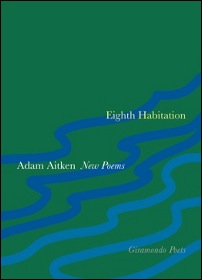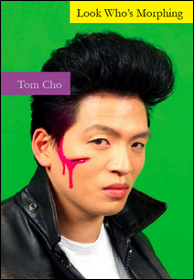|
by Eva Leung
 
Adam Aitken, Eighth Habitation, Giramondo Publishing, 2009. 153 pgs.
Tom Cho, Look Who's Morphing, Giramondo Publishing, 2009. 181 pgs. Writing was sewing. Writing was taking an image–a ferry crossing the Mekong say, and empty it of all significance until it became idea, an image caught between memory and forgetting.
– From "Lines from The Lover" by Adam Aitken British-born Australian poet Adam Aitken knits fabrics of images from the real and imaginary world in his exquisite collection of poetry, Eighth Habitation. In his debut collection of short stories Look Who's Morphing, Chinese-Australian writer Tom Cho sews two worlds together to present quasi-real, unforgettable images. The back cover of Eighth Habitation informs readers that "Eighth Habitation" refers to the "Buddhist notion of purgatory, a mystic realm where the meaning of a human life is judged". Aitken phrases one of his own judgments on human life in the form of a proverb: It took no time at all to learn what I needed
and years to realise what I'd learned
was what I didn't need.
("Essentials: Words and Phrases") He extends his keen observations from matters of the heart to world issues. The collection is an array of postcards, painting a variety of landscapes and depicting various cultural scenes. He treads the grounds of different places in the world. He escorts his readers from "where Mimosa meets Palm" ("Cairns") to Malaysia ("The Curse of the Chicken Rice Hawker, Penang"); he witnesses the Songkhran in Bangkok and a Balinese purification ceremony ("Nyepi"); and he takes us to Cambodia where he walks along the Sivatha Boulevard ("Francais"), visits the Tuol Sleng Genocide Museum in Phnom Penh ("S21") and tastes the smoked fish near the banks of Siem Reap River ("Postcards"). Then Aitken brings readers into imaginary landscapes, where Hindu gods meet ("Shiva, Uma, Ravanna"), where he wakes in "old 'Funan'" ("Aubade 2"), and where the condemned are tortured ("The 32 Hells: A Sampler"). His extensive use of imagery, combined with the diary format of "Archive" and the prose poem of "Lines from the Lover", presents a wide range of subject matter with rich cultural, historical and political references which demands a certain intellectual background from readers. Aitken's readers will discover that he is not taking us on a mere sightseeing tour; rather, he wishes to share his thoughts and feelings. His is a voice of determination, and in the simmering social commentary of his lines, he does not veil brutality in his poetic language. Like a picture formed with a few strokes, he outlines haunting scenes to express concern over warfare: A woman sheltering under a rattan mat
from a thunderous downdraft of Hueys
by the banks of the Mekong;
her last recollection of home.
("Postcards") Then there was the sundowner,
then the bullet point recipes
for WW2 American cocktails.
("Nostalgia") With the same force, he conveys his disgust with manipulative relatives: You discover they lie
those siblings in the mother country, those parasites
who spend each hard-earned cent of your remittances
on Mao Tai and Fan Tan
and still beg for more –
("The Curse of the Chicken Rice Hawker, Penang") As a counterpoint to such serious social commentary, Aitken also writes poems in a lighter, livelier tone to figures both real and imaginary. In "To My Double", he playfully addresses the other "half" of "himself". "For Effendy, Emperor of Icecream" humorously begins with "Effendy, I like the way you avoid work. It is saintly." In "Dear Henri" he goes on an imaginary journey with the Anglo-French explorer Henri Mouhot, while "Coins Falling" brings us back to reality with a letter to poet Agnes Lam, in which Aitken responds to her work of the same title with this ironic opening: Dear Agnes
How I wanted to respond
to your poem 'coins falling'
("Coins Falling") Finally, in a tragically comical manner Aitken slips into the imaginary and speaks in the voice of "Bishma on a bed of arrows" who dwells in the sorrow of being: […] a good loser,
a man who's great
but not quite great enough.
("Aubade 5") While Aitken builds imaginary dialogues and scenarios out of historical and cultural knowledge of the real world, Cho, in his short story collection, merges the real with the imagined. He takes readers by the hand and draws them into a realistic world of fantasy and a fantastic world of reality, where metamorphoses constantly take place. The playful, bizarre and altogether amusing stories feature a young protagonist who shares the same name, age, and nationality with the author, Tom Cho. In the eighteen stories, he and the people around him undergo metamorphoses of all kinds: Tom Cho himself is a Muppet ("Pinocchio"), a robot ("I, Robot"), the Fonz ("The Sound of Music"), a guest of the television show ("Today On Dr Phil"), and later, Whitney Houston's bodyguard ("he Bodyguard"). Elsewhere we see that his transformations know no boundaries, no patterns, and in the title story "Look Who's Morphing" he morphs into Barbara Streisand, Richard Simmons, and Princess Diana. His mother becomes Olivia Newton-John ("Suitmation"), his Auntie Wei is possessed by a demon ("The Exorcist"), and a young girl killed by a group of ninjas returns to life to become a deadly cyborg ("AIYO!!!"). In "Dinner with Auntie Ling and Uncle Wang", Tom Cho the protagonist first presents a perfectly ordinary reality: "I am going to my auntie and uncle's apartment for dinner. I like visiting Auntie Ling and Uncle Wang. They both love hosting visitors." However, this realistic scene soon transforms into fantasy when it is revealed that Uncle Wang has "a bi-directional interface between his central nervous system and a computer", and Cho's persona ends up opening up his head to repair him. While Aitken's juxtaposition of the real and the imagined is clear-cut, Cho blends surrealism and realism to add a grotesque but funny dimension to his stories. As the protagonist shares the author's name and the events involve his relatives and friends, the book seems to offer autobiographic narration, seamlessly morphing into the bizarre and outrageous, linking reality with fantasy, and further blurring the boundary between them. As Cho himself admits, the book is littered with personal responses to various cultural texts such as Gulliver's Travels, Dirty Dancing and The Sound of Music, as well as references to life in the 1980s. Cho's witty portrayals, however, allow readers to enjoy the stories as individual texts. "The Sound of Music" opens with the movie's opening scene: "an aerial view of mountains, then a green valley, and a lake, and suddenly an open grassy area". It is funny to imagine Tom Cho singing there instead of Julie Andrews, but readers without prior knowledge of the film will still find the subsequent scenes with Mother Superior and Captain von Trapp entertaining. Cho's reader response to Gulliver's Travels in the story "Cock Rock" was, however, not my cup of tea. Here Tom Cho the character morphs into a 55-metre-tall rock star performing in Tokyo. I personally found the descriptions of him "enjoying blissful moments" with twenty young girls slightly too explicit; it struck me as a decadent exploitation of women. Yet the effect of this vivid portrayal demonstrates Cho's excellence with description, and I am certain most readers will enjoy the story as it pushes towards the limits of fantasy. Ultimately, I read the book as a metaphor for life and the inevitability of change. Although Tom Cho is passive in most of the transformations, he is always in control of the situations he finds himself, which suggests that though we are often passive in life’s changes, things will turn out fine—his transformations, however disastrous, never go without a happy ending. Spanning the years between 1963 and 2136, Tom Cho's metamorphoses provide a modern variation of Woolf's Orlando. Adam Aitken's moving poems lead readers through past and present with their lyrical language and lucid imagery. Both volumes sew the worlds of the imagination and of the real together, to inspire, to entertain, and to strike a chord that will echo the heartstrings of their readers. |